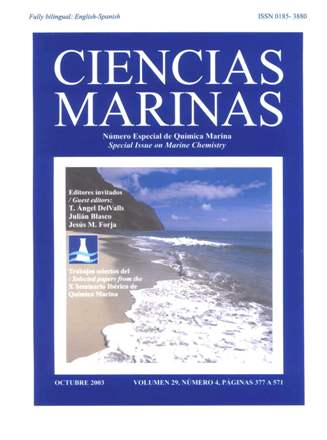Persistent organic pollutants in sediment cores from the southern region of the Bight of the Californias
Main Article Content
Abstract
In January 1998, four sediment cores were collected to reconstruct the history of contamination by persistent organic compounds in the southern region of the Bight of the Californias. Two groups of compounds were determined using chromatographic methods: petroleum hydrocarbons (aliphatic hydrocarbons, AHs, and polynuclear aromatic hydrocarbons, PAHs) and chlorinated hydrocarbons (pesticides and polychlorinated biphenyls, PCBs). The AHs had low concentrations, from 0.30 to 3.38 µg g–1, and presented a biogenic allocthonous origin. The PAH concentrations ranged from 0.99 to 673 ng g–1. The distribution of the alkyl homologues and the compound indices showed a clear predominance of PAHs of petrogenic origin. The chlorinated hydrocarbons presented a surface maximum, decreasing with depth to non-detectable levels. The PCB concentrations ranged from 0.18 to 7.15 ng g–1 and pesticides from 0.09 to 19.71 ng g–1. The pesticides that occurred most frequently were p,p'-DDT and its metabolites (p,p'-DDE and p,p'-DDD). Other pesticides detected were γ-chlordane and BHC isomers (α and γ). The statigraphy of the cores was carried out with molecular markers (chlorinated hydrocarbons), which were used to calculate a rate of sedimentation of 0.17 to 0.55 cm yr–1.
Downloads
Article Details
This is an open access article distributed under a Creative Commons Attribution 4.0 License, which allows you to share and adapt the work, as long as you give appropriate credit to the original author(s) and the source, provide a link to the Creative Commons license, and indicate if changes were made. Figures, tables and other elements in the article are included in the article’s CC BY 4.0 license, unless otherwise indicated. The journal title is protected by copyrights and not subject to this license. Full license deed can be viewed here.

